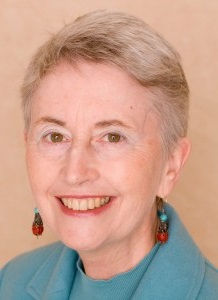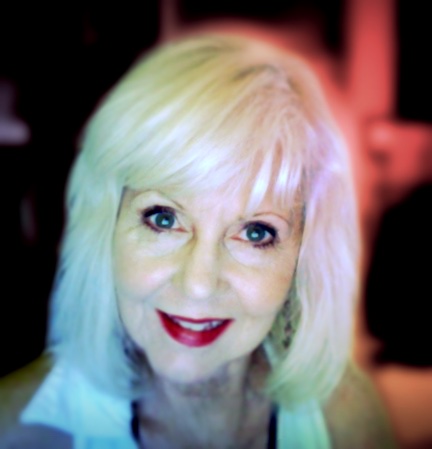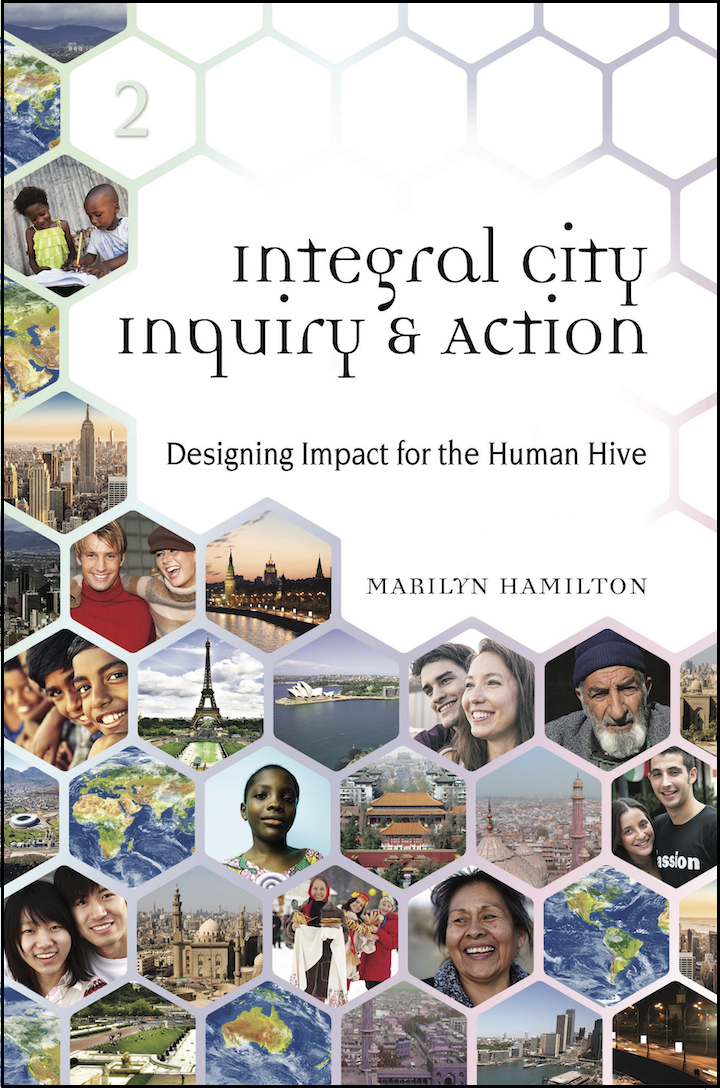ILR’s Jeannie Carlisle interviews Marilyn Hamilton, author of the new work, Integral City Inquiry & Action: Designing Impact for the Human Hive
JC: Hello Marilyn, and welcome! In a few sentences, please describe the premise of this important new book for our readers.
MH: Integral City Inquiry & Action: Designing Impact for the Human Hive is a guidebook for placecaring and placemaking. It offers urban planners the complementary steps to the technology offered by Smart Cities and the necessary consciousness and culture related to the science of Resilient Cities. We provide 16 templates for Action Research practices that engage the 4 Voices of the city – Citizens, Civic Managers, Civil Society and Business – so they can discover Purpose, develop Visions and design the Strategies to implement both placecaring and placemaking.
JC: What inspired you to write this book?
MH: Integral City Inquiry & Action: Designing Impact for the Human Hive is Book 2 in the series of Integral City Books. Book 1, Integral City: Evolutionary Intelligences for the Human Hive introduced the 12 Intelligences that human beings at the city scale need to demonstrate as evolutionary, complex, integral systems. Readers of Book 1 asked for the manual that would help them wake up these intelligences. Since we believe in the evolutionary impulse, we felt we should test out and share the bottom-up change processes of Action Research/Learning. So, Book 2 evolved as we responded to small cities like Durant Oklahoma or whole countries like Russia’s Living Cities initiative to change 1000 cities. At the Integral Theory Conference 2015, I could see how the processes, programs and practices all fit together within an integral methodological framework (to borrow Wilber’s description) so I set out to translate that into an accessible and practical book.
JC: So, would you say that Integral City Inquiry & Action is the manual that readers of Book 1 asked for to “wake up the 12 Intelligences” or is it a book that maximizes the teachings for sustainable or resilient city planning professionals?
MH: This book is designed as a kind of field guide. Each chapter sets out WHAT, WHY, HOW, WHEN – with objectives, clear steps to follow and finishes with Reflections for the Practitioners. These approaches can apply to Individuals working with city individual organizations or sectors, Catalysts bridging multiple sectors or Meshworkers engaging the whole city.
JC: Who were your intellectual influences for your new book?
MH: My intellectual influences in thinking about the entire Integral City Series are Ken Wilber for the Integral Model; Don Beck and Clare Graves for the evolutionary spiral of human development; James Grier Miller for living systems; Margaret Wheatley for complexity theory; Jane Jacobs for rethinking the city; James Lovelock for the Gaia Theory; Mark DeKay for Integral Sustainable Design; Sean Esbjörn-Hargens and Michael Zimmerman for Integral Ecology; Barrett Brown for Integral Sustainability; Rupert Sheldrake for field theory; Gunderson & Hollings for Panarchy; and Howard Bloom, Maeterlink and Gould & Gould for the Honey Bee.
JC: Sometimes people who are considered experts in his or her field don’t appear to discover anything new when writing about their subject. What new learning did you take away from your research while working on the book?
MH: This book has been developed from working in the field over the last 10 years. Each of the chapters describes a process, practice or program that we have developed and can be applied by any of the 4 City Voices. We discovered that you don’t have to change the city from a top down approach, but anyone, whether they are Citizens, Civic Managers, Civil Society or Business can initiate change. We discovered that there is a natural sequence to engaging people – a kind of “U Pattern” at the city scale. We have organized the chapters so users can follow this pattern – but we have also discovered the practices can be implemented in a non-linear manner. So, our learning might be expressed as when you want to change the city, follow the energy in your community, neighborhood or city – and be open to both a linear and non-linear path of discovery.
JC: Do you think that sustainable cities can be created and maintained without incorporating principles of Integral Theory?
MH: I think sustainable cities are not so much created or maintained – but rather they emerge and adapt like the living human systems they are. Cities are always evolving and when I think about sustainability and cities I am always considering the sustainability of our living planet.
I think of cities as Gaia’s Reflective Organs (influenced by James Lovelock) and as such they are the most complex human system yet created. I also call cities, Human Hives. As a species, humans are still very young (compared to the most advanced species of the invertebrates – the honey bee – which are 100 million years old) and as individuals and organizations we are cells and organelles in Gaia’s Reflective Organ. This framing of Integral Cities as Human Hives embraces holons, social holons, holarchies, quadrants, levels, lines, stages, states.
It also depends on the interaction of the natural fractal patterns of human systems at different scales that impact the dynamics of all scales locally, regionally and globally. When we translate all this complexity into the consciousness and culture that I believe seed, nurture and influence cities, the only way we can comprehend sustainability and hold all this complexity is within an integral model. So, I would probably suggest we reframe the question and ask: how do principles of Integral Theory influence our understanding of sustainability and cities.
JC: Do the rise of technology and the subsequent increased ease of accessing information have a positive or negative effect on the structure of sustainable cities?
MH: The rise of technology and the increased ease of accessing information impacts structures and relationships in cities – whether they are sustainable or not. I do not think we can consider cities alone sustainable – we must consider cities in relationship to their eco-regions and planet as well. Eventually I imagine that we will have a Planet of Integral Cities – where we will necessarily be connected by structures in technology, information and relationships – not just in the built environment but also across the natural environment.
Too many people think of cities as structures of bricks and mortar and hard-wired technologies (including the Chinese who have built whole cities that remain largely empty of people). Whereas, I believe that our consciousness, cultures and relationships are constantly creating morphic patterns in the energy field – especially where we congregate in dense hives like cities. Recent interest in “we-space” practices is starting to tap into this type of “consciousness technology.” We even introduce one approach in our first 2 chapters of Integral City Inquiry & Action – where we share our practices and experience of Systemic Constellation Work.
JC: Well said, Marilyn. Is there anything else you’d like potential readers to know about your book?
MH: If you are an Action Researcher or Action Learner, this is a natural way to translate your facilitation skills from small groups and organizations to city scale. Dive in and experiment!
If you are a city planner looking for a way to hold the complexity and tension of our human hives, consider how the integral framework can help you keep the best practices of what you are currently using and integrate many partial solutions into an integrated whole.
If you are an integralist who has been working with individual or group mindfulness practices, bring your skills to the larger city scale of human systems where more than 50% of the people in the developing world live and 90% of the people in the developed world hang out. We need facilitators who can work at all scales to connect, collaborate and catalyze change in Gaia’s Reflective Organs.
About the Authors

Marilyn Hamilton
Marilyn Hamilton PhD, CPA/CGA Founder and President Integral City MeshworksA city evolutionist, prAQtivist, author, researcher and academic, Marilyn co-creates a global constellation of Integral City Meshworkers, Learning Lhabitats, Peer Associations and City Institutes. She incubates resilience and transformation strategies with Civic Leaders, Civil Society, Business and Community Voices that enable the Human Hive – Gaia’s Most Reflective Organ – to balance Place Caring with Place Making.

Jeannie Carlisle
Jeannie Carlisle PhD, Management Review Board member for ILR, a partner in Integral Publishers, LLC, and Chief of Editorial and Acquisitions for Tangent Publishers.


Pingback: Integral City brings urban planners a new tool for building sustainable, smart cities – MONEY® News